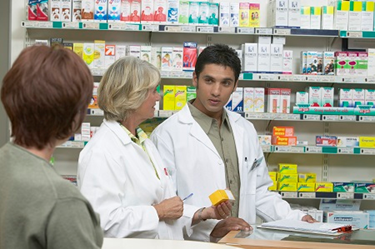What Pharmacists Need From Biosimilar Developers
A conversation with Steven Lucio, associate VP, Pharmacy Services, Vizient Inc.

Pharmacists can play an important role in the biosimilar ecosystem, educating prescribers about the benefits of biosimilars and serving as final gatekeepers to their adoption. For a behind-the-lines perspective on pharmacists’ current views regarding biosimilars — and what developers should be doing to engage them as allies in driving biosimilar uptake — we reached out to Steven Lucio of Vizient Inc., a group purchasing organization (GPO) with over $50 billion in total member spend. As associate VP of Pharmacy Services, Lucio provides education to Vizient’s member organizations on topics such as benchmarking pharmacy costs for critical drug classes, evaluating the expense of high-cost biologics, and preparing for implementation of biosimilar medications.
Generally speaking, how well versed are pharmacists today in the world of biosimilars? In which areas do you feel they need greater education (e.g., clinical profiles, regulatory processes, interchangeability, etc.)?
 Pharmacists are increasingly aware of biosimilars, given the fact that we now have several on the market. Additional outreach and education still needs to be done to increase their understanding of the nuances of regulatory and approval processes. The subtleties of approval processes for small molecule medications versus biologics — and the technicalities of recombinant engineering and analytical characterization — are essential to any pharmacist’s ability to evaluate biosimilars for adoption and, more importantly, to answer questions of reluctant prescribers. To help pharmacists gain this knowledge, we encourage them to view the approval of every biosimilar as an opportunity to familiarize themselves with the intricacies of each new product entry and share that information with their team and their physician colleagues.
Pharmacists are increasingly aware of biosimilars, given the fact that we now have several on the market. Additional outreach and education still needs to be done to increase their understanding of the nuances of regulatory and approval processes. The subtleties of approval processes for small molecule medications versus biologics — and the technicalities of recombinant engineering and analytical characterization — are essential to any pharmacist’s ability to evaluate biosimilars for adoption and, more importantly, to answer questions of reluctant prescribers. To help pharmacists gain this knowledge, we encourage them to view the approval of every biosimilar as an opportunity to familiarize themselves with the intricacies of each new product entry and share that information with their team and their physician colleagues.
Examples of recommended materials for pharmacists to review include:
- FDA approval documents and the expanded educational information provided on the FDA’s website
- Results of the manufacturer’s conformational clinical trials provided to clinical journals
- Other overview documents in clinical literature, as well as books on biosimilars
The information I have found that resonates most with physicians is the data showing how all biologics (including branded products) vary. This understanding helps prescribers realize that the concept of highly similar (not exact replicas) biologics existed prior to biosimilars. The other element that helps is the clinical practice guidelines (many from Europe) that increasingly reflect an acceptance of biosimilar use.
What are pharmacists’ biggest objections when it comes to biosimilars?
The biggest source of frustration is the duration of time required for the biosimilar market to develop in the U.S. While 11 biosimilars have been approved by the FDA, only three are presently marketed. Two others should enter the market by the end of the summer. However, biosimilar competition for products such as Rituxan, Avastin, and Herceptin will not arrive until 2019, and a competitor for Humira is not expected until 2023. The slow progression of approval and uptake has made it hard for pharmacists to maintain the attention of their physician colleagues. We continue to encourage pharmacists not to lose their focus on biosimilars, particularly since quite a few products (as stated above) could enter the market next year.
Are there any traditional practices within the pharmacy, or on the business/contracting side of things, that could block biosimilar use?
The biggest perceived barrier to biosimilar use has been the lack of alignment between provider and payer formularies. Most biologics for which biosimilars are anticipated are administered in an outpatient infusion setting or dispensed via a retail (usually specialty) pharmacy. As such, the selection of a product by a physician (or for a pharmacist making a formulary recommendation) is a combination of both acquisition price and related reimbursement.
During this formative time period, an increasing number of providers have attempted to use biosimilars due to lower cost opportunities. However, the selection of preferred product has not always aligned with payers’ decisions, which in some cases have assigned a preferential designation to the originator biologic. This lack of alignment has further slowed the opportunity for uptake and remains an issue that payers, providers, and biosimilar manufacturers must continue address.
How will these need to be addressed in order to help pharmacies more seamlessly introduce biosimilars?
The resolution requires proactive communication between all parties involved in product selection. Providers and payers must communicate closely regarding formulary decisions and look for opportunities to include biosimilars. Biosimilar manufacturers must have a well-researched approach to obtain and sustain payer coverage that is at least equivalent to that of the originator brand.
Biosimilar Development published an article a few years ago arguing retail pharmacies are well-prepared for biosimilars. Do you agree with this argument? Why or why not? Do you feel the same argument holds true for specialty pharmacies?
I think there are many aspects of existing pharmacy practice (hospital, retail, and specialty) that are supportive and will continue to enable the introduction of biosimilars. All of these environments (and the pharmacists working within them) are proficient with the development and implementation of formulary management strategies. Each group knows how to manage the use of chemically distinct, yet therapeutically similar, medications. While we are still in the formative age of the biosimilar paradigm, we will rely on this type of infrastructure to establish and sustain the market for highly similar biologics. As familiarity and trust increases due to comparable outcomes with biosimilars, hopefully we will reach a market environment that more closely resembles that of the generic mindset.
Unlike small molecule generics, state legislation specifies that a biosimilar must be interchangeable to be substituted automatically. Do pharmacists look at interchangeability as a positive or problematic development for biosimilars? Will this practice introduce any unique challenges for the pharmacist?
Right now, interchangeability is probably viewed as more of a complicating factor than an enabling resource for biosimilar adoption, due to the novelty of the interchangeability concept and the difference associated with management of high-cost biologic drugs.
While the FDA has the authority to designate a competing product as an interchangeable biologic, the way in which this step occurs and its relevance is very confusing. Only recently has the FDA stated — in draft form — what steps would be required to achieve this designation. In addition, it remains unclear as to whether or not biosimilar manufacturers will need to invest in this additional development expense, or if they will achieve adequate uptake of their products without pursuing this designation.
Also, while interchangeability has been perhaps the most essential enabler of generic drug growth, the market for biologics is different. Given their complexity, limitations on routes of administration (parenteral only), and high cost, biologic drugs are either administered by a healthcare provider in a hospital, outpatient setting, or physician’s office or are dispensed via a specialty pharmacy (for those than can be self-administered).
Due to the clinical and economic needs for additional monitoring, product selection is heavily influenced by an inpatient pharmacy and therapeutics committee decision and/or a payer’s formulary. Outpatient-administered and/or -dispensed drugs usually require a prior authorization. As a result, the selection of biologic is not simply at the discretion of a dispensing pharmacist (as in the case of orally administered generics), but is subject to additional review and scrutiny prior to a final order and/or prescription. Due to these complicating factors, the importance and utility of interchangeability remains uncertain.
In addition to continuous education, what else can biosimilar makers do to gain greater support from the pharmacist community?
At the end of the day, the argument for biosimilars is a financial one. These agents are intended to provide the same clinical outcome as the originator biologics to which they are compared. In the absence of superior clinical performance, the differentiating opportunity involves comparative expense. Biosimilar manufacturers must offer meaningful value to encourage increased evaluation and use. This economic proposition must address not only acquisition cost but also adequate reimbursement.
